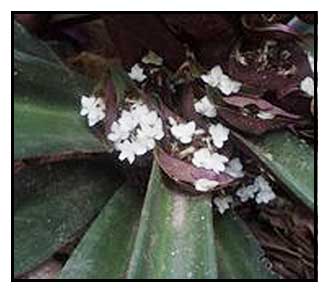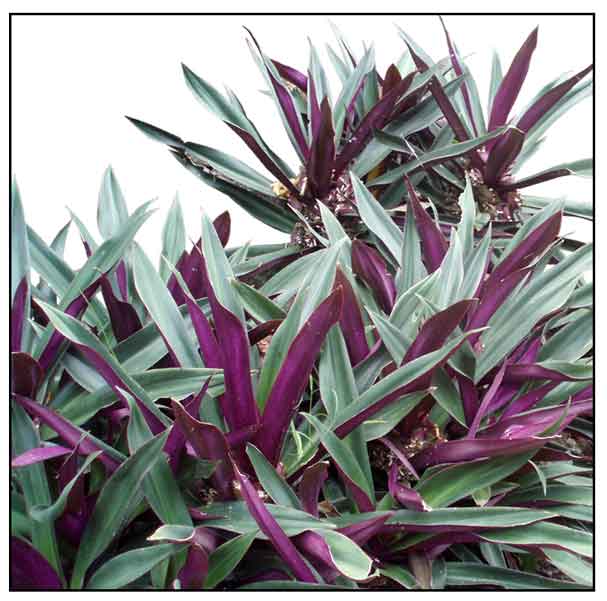|
Etymology
- Tradescantia is named after John Tradescant senior, gardener to Charles I. He collected the first tradescantia from Virginia in the USA. Spathacea refers to the spatula-like leaves. Its common names are Moses-in-the-cradle, Oyster Plant and Boat Lily.
-
Moses in a Cradle: The small white
three-petaled flowers (Moses) arise from within the boat-shaped purple
bracts (the cradle) nestled between the leaf axils.
B otany otany
Bangka-bangkaan is a stout perennial herbaceous, somewhat fleshy
plant, 0.5 meters in height or less, the stem thick and unbranched. Leaves are lanceolate, acuminate, 40 to 60 centimeters long, 4 to 6 centimeters
wide, fleshy, the upper surface dark green, the lower purple. Â Flowers are numerous in each inflorescence, fascicled, white,
about 1 centimeter in diameter. Inflorescence, axillary, short, peduncled, the
flowers surrounded by 2 large, imbricate, laterally compressed, distichous,
3 to 4 centimeters long purplish bracts.
Distribution
- Ornamental cultivation.
- Grown for bedding, rock gardens and ground cover.
-
Scarcely
established.
Constituents
• Phytochemical studies yielded alkaloids, flavonoids, steroids,
saponins, cardiac glycosides, terpenoids, tannin and phenolic compounds
and oil.
• Leaf analysis yielded the presence of secondary metabolites such as alkaloids, flavonoids, glycosides, and tannins. (19)
• Ethanolic plant extract yielded anthocyanins, flavonoids, saponins, caroternoids, terpenoids, and steroid compounds. (see study below)
(27)
• Phytochemical screening of leaves revealed the presence of secondary metabolites such as alkaloids, flavonoids, glycosides, saponins, and tannins. (see study below() (28)
Properties
• Decongestant, expectorant,
blood refrigerant, antidysenteric.
• Reported anti-inflammatory, anticancer, insecticidal, antimicrobial, antifertility properties.
• Studies have suggest antioxidant, antibacterial, antimutagenic, antigenotoxic, antitumor properties.
Parts utilized
Flowers, leaves.
Collect the whole year round. Sun-dry.
Uses
Edibility
• Leaves and flowers reportedly used in making tea. (17) (18)
• Decoction and infusion of leaves recognized as functional food particularly in South America.
Folkloric
• Decoction of dried or fresh leaves used for cough, colds, hemoptysis, whooping cough, nose bleed.
• Bacillary dysentery, blood in the stool.
• Used for lymphatic tuberculosis.
• Used by Ayta communities of Porac, Pampanga for inflammation, sprains, and fractures. (26)
• In Singapore,
sold in markets as both ornamental and medicinal: Boiled in water, it
is believed to have cooling properties.
• In Thai medicine, used for fever, cough and bronchitis.
• In Cuba, frictions and cataplasms used to treat wounds.
In the Caribbean, poultice of leaves used for asthma.
(11)
• In Puerto Rico, decoction of leaves used in the treatment of psoriasis. (15)
• In Mexican traditional medicine, leaves used for the treatment of "nervios." (20) Leaf elixir used for the treatment of endoplasmic carcinoma.
(27) Used for the treatment of superficial mycoses.
• In Bangladesh, leaf juice is mixed with sugarcane juice and taken to treat bloody urine in women. (31)
Others
• Ornamental: Cultivated as an ornamental plant.
Caution
!
The plant sap is considered poisonous.
Contact may cause stinging and itching of the skin and eyes. Ingestion
may cause irritation of the lips, mouth, throat and abdominal pain.
Studies
• Anti-tumor / Chemoprevention: Aqueous crude extract of Rhoeo
discolor decreases the formation of liver preneoplastic foci in rats – In Mexico, Rhoeo discolor has been used to treat cancer. A study was
done to validate its antitumoral property. It showed a reduction of
preneoplastic lesions and justifies continuing further studies for its
chemoprevention potential. (1)
• Antigenotoxic, Antimutagenic and
ROS Scavenging Activities: Study evaluated an ethanolic crude extract from Rhoeo discolor for antigenotoxic, antimutagenic, and ROS scavenging activities. Study
evaluated its antimutagenic and antigenotoxic activities.
The extract was neither mutagenic nor genotoxic. On free radical scavenging test, its antioxidant activity was less than quercetin, similar to
α-tocopherol, and more than ascorbic acid. showed dome radical
scavenging, less than α-tocopherol and more than ascorbic acid. (2)
• Antimutagenic Mechanism: Study of antimutagenic mechanisms showed the extract might be used to avoid DNA damage by alkylation, corrected alkylguanine transferase protein encoded with ogt gene. (5)
• Antimicrobial / Phytochemical
Constituents: Phytochemical studies yielded alkaloids,
flavonoids, steroids, saponins, cardiac glycosides, terpenoids, tannin
and phenolic compounds and oil. Study showed good inhibitory activity
with dose-dependent increase in effect. K pneumonia was found to be
most susceptible. (4)
• Stimulation of Human Lymphocyte Proliferative Response: Study evaluated the effects of various extracts of 8 Thai medicinal plants for in vitro stimulating human lymphocyte activity. All the extracts significantly stimulated human lymphocyte proliferative responses at varying concentrations. Results suggest potential for clinical use for modulating immune functions of the body. (9)
• Antimicrobial / Phenolic Rich Extracts: Study evaluated the in vitro activity of phenolic rich extracts against chosen microorganisms of human health importance viz., Listeria innocua, Streptococcus mutans, Escherichia coli, Pseudomonas aeruginosa and Candida albicans. While P. aeruginosa was least affected by extract exposure, low doses of the extracts produced significant bacteriostatic and bactericidal effect on the rest of the microorganisms. (13)
• Anticancer / Hepatoprotective: Study showed the protective effects of Rhoeo discolor aqueous crude extract against rat liver cancer using the resistant-hepatocyte model. The aqueous crude extract reduced the number and area of preneoplastic lesions. Results suggest justification for pursuing studies on chemoprevention strategies as an option in the treatment of cancer. (14)
• Antioxidant / Leaves: Study evaluated aqueous leaf extracts of Rhoeo spathacea for antioxidant (DPPH, FRS, FRP, and FIC assays) and antibacterial activity. Infusions and decoctions were found to have comparable TPC and antioxidant activity with other herbal teas. Both decoction and infusion showed antibacterial activity against six species of Gram positive and four species of gram negative bacteria, notably MRSA and Neisseria gonorrhea. (16)
• Antiviral Activity / Cytopathic Inhibitory Effect on Vero Cells: In a study of twenty Malaysian medicinal plants for anti-Chikungunya virus activity, ethanol, methanol, and chloroforms leaf extracts of T. spathacea showed the strongest cytopathic inhibitory effect on Vero cells, with cell viabilities of 92.6%, 91.5% and 88.8%, respectively. The chloroform extract showed CC50 of 285.5±3.1 µg/ml and EC50 of 69.2±0.6 µg/ml. (19)
•
Anticancer: Paper reported on the anticancer properties of leaves of Tradescantia spathacea and over-expression of ß-catenin protein in lung adenocarcinoma (A549 cell lines), prostate cancer (PC-3) and hepatocellular liver carcinoma (HepG2). Results showed rich anticancer activity against the three cell lines via suppression or inhibition of over-expression of ß-catenin protein. (21)
•
Antimycobacterial: Study evaluated five selected Indonesian endogenous medicinal plants (A. paniculata, A. muricata, C. asiatic, P. indica, and Rhoeo spathacea) against clinical isolate of multi-drug resistance (MDR) Mycobacterium tuberculosis. Rhoeo spathacea showed 100% inhibition of Mycobacterium tuberculosis H37Rv strain and 100 inhibition against MDR strain. Pluchea indica and Rhoeo spathacea showed good antimycobacterial activity against MDR strains and showed potential as complementary alternative therapy in treatment of emergent MDR strains of MTb. (22)
•
Antioxidant / Antibacterial / Leaves: Study evaluated the viability of R. spathacea leaf extracts as a beverage, in terms of antioxidant and antibacterial activity. Aqueous leaf extracts in forms of decoction and infusion were shown to have comparable TPC and antioxidant activity with other herbal teas. Both decoction and infusion exhibited antibacterial activity against six species of gram positive and four species of gram negative bacterial, notably MRSA and Neisseria gonorrhea. Both decoction and infusion of leaves have potential to be popularized into a common beverage. (23)
•
Phytoremediation Potential / Antibacterial / Leaves: Study evaluated the use of R. discolor as a phytoremediation plant. Chrysopogon zizanioides, a phytoremediation plant, was used as positive control. Both plants were exposed to 144 h. to leachates from a sanitary landfill for urban waste. Elements identified in R. discolor exposed to leachates were quartz, CaCO3, and thiocyanate. In both species, exposure to leachates were associated with an increase in concentration of Cu, K, Mn, Ni, and S In R. discolor, the concentration of S increased 25 times. Results suggest R. discolor as potential as a phytoremediation plant. (24)
•
Invention / Use in Cosmetics and Pharmaceutics: Invention describes the use of Rhoeo discolor plant extracts in cosmetics and pharmaceutics, in particular, in dermatology. The aim is to improve the differentiation of keratocytes and/or to fight against the ill effects of free radicals and/or to improve the synthesis of glycosaminoglycans. The incorporation serves to improve skin hydration, softness and firmness, and fight against skin ageing effects. (25)
•
Biologic Activities: Successive solvent extract of the plant has shown antioxidant activity, antimicrobial properties, and also found to block antiadrenergic action of bretylium tosylate and contraceptive effect in experimental animals. (see constituents above)
(27)
•
Anti-Chikungunya Virus Activity: Chikungunya virus as a reemerging arbovirus transmitted mainly by Aedes mosquitoes. In a study that evaluated 120 extracts from selected medicinal plants, the ethanol, methanol, and chloroform extracts of Tradescantia spathacea leaves showed the strongest cytopathic effect inhibition on Vero cells. However, the chloroform extract of Rhapis excelsa leaves showed the highest percentage reduction of viral load, followed by ethyl acetate extract of Vernonia amygdalina. Active extracts of T. spathacea, in addition to its virucidal effect, might also inhibit the release of of mature virus from the infected cells and prevent the spread of the virus to other cells/ (see constituents above) (28) Chan et al study of the invitro activity of T. spathacea showed the leaf extract to be a powerful anti-chikungunya plant. The ethanol and methanol extracts at concentrations of 512 µg/ml showed strong inhibitory activity against CHIKV with cell viabilities of 93% and 91%m respectively/ Quantitative RT-PCR showed percentage reduction in viral load of ethanol, methanol, and chloroform extracts were 52%m 46%, and 84%, respectively. Results suggest the plant may inhibit the virus from inhibiting other cells and also have a direct virucidal effect. (33)
•
Antifungal / Toxicity Study: Study evaluated The aerial parts or leaves of four medicinal plants for antifungal activity against four species of yeast and two species of filamentous fungi. The toxicity of the extracts were tested against African monkey kidney epithelial (Vero) cells. All 24 extracts from the four medicinal plants showed inhibitory activity against all fungal species, except for Aspergillus fumigatus, with more pronounced activity on yeast then filamentous fungi. The less polar extracts (hexane, chloroform, and ethyl acetate) showed more activity than the more polar extracts ( ethanol, methanol, and water). The less polar extracts showed relatively higher toxicity to Vero cells. T. spathacea did not show significant toxicity to Vero cells (p>0.05). Study suggests T. spathacea has the most promising pharmaceutical potential because of its broad spectrum and selective activity against human fungal pathogens. (29)
•
SnO2 Nanoparticles ,/ Photoantioxidant / Leaves: Study reports on the phytogenic, easy, cost-effective and green synthesis of tin oxide nanoparticles (SNO2NPs) using an aqueous leaf extract of T. spathacea. FTIR spectra exhibited the presence of hydroxyl groups, amines, alkenes and phenols from the leaf extract. The showed enhanced photoantioxidant activities SNO2NPs under visible light radiation. (30)
•
Antidiabetic / Alpha Amylase and Alpha-Glucosidase Inhibitory Activity: Study evaluated the antidiabetic a methanolic extract of Tradescantia spathaea and compared the α-amylase and α-glucosidase inhibitory activity with acarbose. In an alloxan-induced diabetic model, the extract showed α-amylase and α-glucosidase inhibitory activity. The antidiabetic effect was attributed to flavonoids. Results suggest potential as antihyperglycemic agent for diabetic patients. . (32)
•
Cancer Cell Specific Cytotoxic Effect: Study evaluated the cytotoxic effects of extracts of R. discolor against three representative human cancer cell lines: HT-29 colon cancer, Hep-G2 liver cancer, and PC-3 prostate cancer cell lines. Results showed low concentrations of the crude bioactive extracts and fractions were effective a cancer specific cytotoxic agents, showing significant proliferation inhibition on the cancer cell lines. The most effective extracts were mainly water, methanol and ethanol based. (34)
Availability
- Wild-crafted. |



 otany
otany

